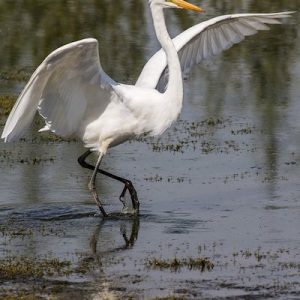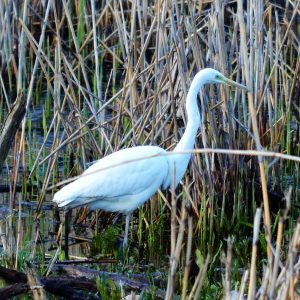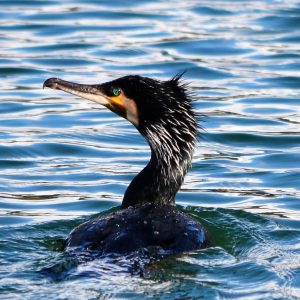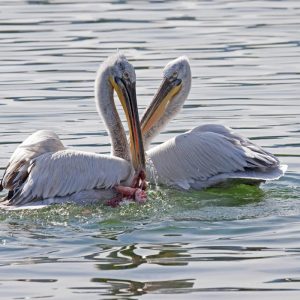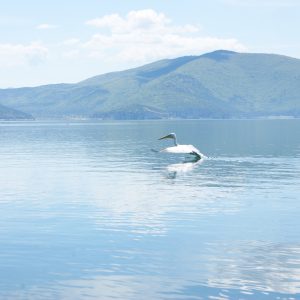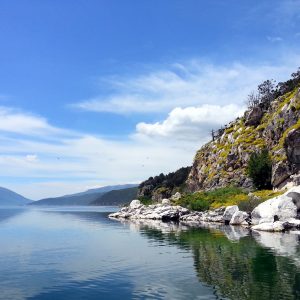Prespa has lots to offer for anyone interested in birds and their behavior. For bird watching enthusiasts we are glad to arrange private full day trip on lake Prespa to the Ezerani nature reserve or the area of the island of Golem Grad, unique locations with very diverse bird fauna.
Everyone from the complete beginner to the dedicated ornithologist will find bird-watching experiences to suit their taste. Many species can easily be seen with the naked eye, although a pair of binoculars helps to get really good views of birds without disturbing them. For those lucky enough to have telescopes there are plenty of opportunities to see close-up views of birds that are not so easy to find elsewhere. Please take great care not to disturb the birds that you enjoy, especially during the breeding season when they are particularly vulnerable.
Birdwatching – Photo Safari
Prespa is located on the southwest corner of Macedonia and is a region shared with Greece and Albania. Beside its beautiful scenery, it is also of great value thanks to its wildlife, both mammals and avifauna. It is by all means one of the most important areas for birds in the region of Southeast Europe.
The most noteworthy bird species is the Dalmatian Pelican (Pelacanus crispus), whose population has increased significantly and forms a considerable portion of the world’s population as a result of successful protection efforts. In Prespa there is a mixed colony which also includes Great White Pelicans (Pelacanus onocrotalus). Also noteworthy is the small, southernmost European colony of the Goosander (Mergus merganser).
Other important waterfowl species breeding in Prespa are the Greylag Goose (Anser anser), which breeds in just few sites in the area, also the threatened Ferruginous Duck (Aythya nyroca).
Moreover, a lot of Herons species can be found here, most of which breed on the lakes. The Grey Heron (Ardea cinerea), the Purple Heron (Ardea purpurea), the Little Egret (Egretta garzetta), the Great White Egret (Casmerodius albus), the Squacco Heron (Ardeolla ralloides), the Little Bittern (Ixobrychus minutus), the Night Heron (Nycticorax nycticorax), the Bittern (Botaurus stellaris), the Glossy Ibis (Plegadis falcinellus) and the Eurasian Spoonbill (Platalea leucorodia) can be observed in the area. The Glossy Ibis has started breeding again on the lakes after a long absence. The Pygmy Cormorant (Phalacrocorax pygmeus) is another important and numerous species. The Bearded Reedling (Panurus biarmicus) can easily be found in the dense reeds of the lakes. Finally, the Marsh Warbler (Acrocephalus palustris) also breeds here.
In addition, the area around the lake is a mixed agricultural- landscape, also of great interest to birdwatchers and bird photographers. From mid-spring until the end of the summer Golden orioles (Oriolus oriolus) are well hidden in the dense tree canopies singing their beautiful melancholy song. On the contrary, colorful Bee Eaters (Merops apiaster) with their characteristic calls can be spotted very easily. Furthermore,
A very special species is found among the shrubs of these habitats, the Barred Warbler (Sylvia nisoria). Prespa is one of the very few areas where this species breeds. Last, the Dipper (Cinclus cinclus) breeds in perennial streams.
It is to be expected that a lot of raptors take advantage of such a variety of birdlife. The number of raptor species varies depending on the season. The most important are: the Peregrine Falcon (Falco Peregrinus), the Short toed Eagle (Circaetus gallicus), the Levant Sparrowhawk (Accipiter brevipes) and, last but not least, migrant Circus species like the Montagu’s Harrier (Circus pygargus).
The Great Prespa lake is on a plateau surrounded by Mt. Baba (˃ 2000 m) and Mt. Galicica. It is worth an effort to go up in the mountains where many very interesting species of woodland and alpine fields can be found. At low altitude, where the habitat is dense, mixed woodland, one can observe the breeding Eastern Bonelli’s Warbler (Phylloscopus orientalis) and the Semi-collared Flycatcher (Ficedula semitorquata). Higher in the conifer forests, there are many woodpecker species, including the Black Woodpecker (Dryocopos martius) and the White Backed Woodpecker (Dendrocopos Leucotos). Other notable forest species are the Willow Tit (Parus montanus) and the Tree Creeper (Certhia familiaris). At the alpine fields, the Rock Thrush (Monticola saxatilis), the Yellowhammer (Emberiza citrinella), the Horned Lark (Eremophila alpestris) and the Ortolan Bunting (Emberiza Hortulana) are likely to come across. The Wryneck (Jynx torquilla) breeds in the area, which is very rare in the rest of the region. In the forests but also higher than the tree line, several raptor species can be seen, like the Honey Buzzard (Pernis apivorus), the Goshawk (Accipiter gentilis) and the emblematic Golden Eagle (Aquila Chrysaetos).
For those who enjoy exploration and are attracted to extra difficult species, a possible encounter with a Hazel Grouse (Tetrastes bonasia) is another good reason to visit Prespa.
